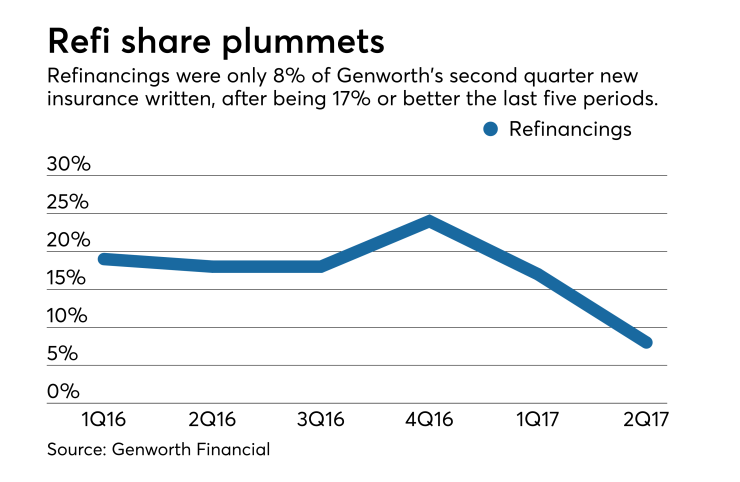Genworth Financial's U.S. private mortgage insurance business had an almost 50% increase in adjusted operating income, benefiting from lower-than-expected claim rates.
The U.S. MI business had $91 million in adjusted operating income, compared with $61 million
It had new insurance written of $9.8 billion during the quarter, down from $11.4 billion one year prior.
However, the bulk of that drop was from refinance business, to $800 million for the second quarter from $2.9 billion one year prior. The decline in new insurance on purchase loans was approximately 4%, to $9 billion, from $9.4 billion one year prior.
Genworth's delinquent loan inventory dropped to 20,677 mortgages from 23,019 as 10,118 loans were removed because a claim was paid or the borrower resumed making payments, while 7,776 new loans were added.

Genworth Financial, which has a life insurance business as well as stakes in mortgage insurers in Canada and Australia, reported net income of $202 million, compared with $172 million one year prior.
The deadline for its
"Genworth strongly believes the pending transaction with Oceanwide is the best option for our shareholders, policyholders and other stakeholders," said Genworth President and CEO Tom McInerney in a press release. "The transaction will strengthen Genworth's financial position in the mortgage insurance and long term care insurance markets."
NMI Holdings Inc., the parent company of National MI, had net income of $6 million in the second quarter, up from $2 million
The most recent results include $3.1 million of fees and expenses from its insurance-linked notes issuance in May.
National MI had $5.04 billion of NIW, down 14% from $5.84 billion one year prior.
"We made significant strides in customer development, activating 36 new customers in the second quarter and 73 new customers for the year-to-date," said Chairman and CEO Bradley Shuster in a press release.
While it will take time to get these new relationships active, "We believe the company's market share will move through the high single digits and into the low double digits," said FBR Capital Markets analyst Randy Binner in a research note. "With this should come better scale in the business that we believe will make small loss and expense items stand out less quarter-to-quarter."
Insurance-in-force grew 64% to $38.6 billion from $23.6 billion one year earlier.





